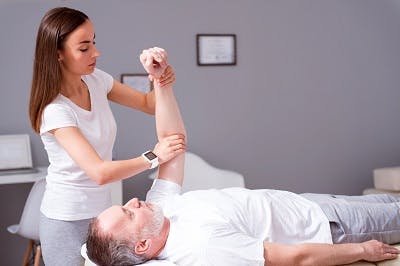About 67-78% of individuals experience some degree of spasticity after spinal cord injury.
Spasticity after SCI describes involuntary muscle contractions caused by disrupted signals between the brain and areas below the level of injury.
To help you better understand spasticity, this article will discuss:
- Why Spasticity Occurs After Spinal Cord Injury
- Spasticity and Spinal Shock
- Consequences of Spasticity After Spinal Cord Injury
- Is it Possible to Permanently Relieve Spasticity?
- How to Manage Spasticity After SCI
Why Spasticity Occurs After Spinal Cord Injury
Spasticity describes involuntary muscle contractions that are triggered by movement.
It is velocity-dependent, meaning that the quicker a muscle is stretched, the more severe its contraction. As a result, individuals with spasticity typically experience stiff movements and jerky spasms.
Following a spinal cord injury, messages between the brain and areas below the level of injury may not be able to get through the site of injury. Consequently, when spinal reflexes activate a muscle contraction, signals from the brain to relax may not be able to reach that muscle, resulting in prolonged contraction.
Some individuals may not experience spasticity immediately after their spinal cord injuries. Especially if they are in spinal shock and initially demonstrate very low muscle tone, the sudden onset of spasticity can be startling. In the following section, we’ll discuss what spinal shock is and why individuals with low muscle tone may gradually experience very high muscle tone.
Spinal Shock and Spasticity
Following a spinal cord injury, individuals may experience a temporary but complete loss of motor control, sensation, and reflex activity below their level of injury. This is called spinal shock, and it occurs because swelling and inflammation following an SCI can restrict blood flow.
Spinal shock consists of 4 stages that can last anywhere from days to months depending on the severity of the SCI. Initially, individuals with spinal shock experience a state of hyporeflexia (underactive reflexes) or areflexia (no reflexes). As spinal shock progresses, individuals experience the opposite effect: hyperreflexia (overactive reflexes), which is a type of spasticity.
However, even after spinal shock goes away, individuals with spinal cord injuries may continue to experience spasticity. Therefore, it’s essential to learn how to manage spasticity to reduce its impact on your everyday life.
In the following section, we’ll discuss potential consequences of spasticity after spinal cord injury.
Learn more about spinal shock after spinal cord injury »
Consequences of Spasticity After Spinal Cord Injury

It’s essential to seek management for spasticity after spinal cord injury because muscles can continue to contract, causing additional complications.
Poorly managed spasticity may cause:
- Limited range of motion
- Pain/ discomfort
- Difficulties with balance and coordination
- Loss of ambulation (ability to walk)
- Body distortions due to uneven muscle strain
- Increased risk of pressure sores
- Increased risk of joint subluxation or dislocation
However, a little bit of spasticity is not always a bad thing. In fact, spasticity can be viewed as a good sign of spinal cord injury recovery. It indicates that neural connections between the brain and areas below the level of injury exist.
Additionally, spasticity can help individuals stand and bear weight, which may improve circulation and reduce their risk of muscle atrophy and osteoporosis.
In the following section, we’ll discuss the importance of spared neural connections after spinal cord injury.
Is it Possible to Get Rid of Spasticity After Spinal Cord Injury?
While spasticity affects the muscles, the key to relieving it lies within the central nervous system.
While damage to the central nervous system is irreversible, the brain and spinal cord are extremely adaptable. Neuroplasticity refers to the central nervous system’s ability to reorganize its neural circuits based on behavior. Consistently practicing high repetitions of task-specific exercises and activities helps reinforce demand for those functions and promotes neuroadaptive changes.
When those motor functions are rewired to healthy, undamaged regions of the spinal cord, messages between the brain and areas below the level of injury are no longer obstructed, resulting in no more spasticity.
This is much easier said than done, but with patience and consistency, long-term improvements are possible. Up next, we’ll discuss various management interventions for spasticity after spinal cord injury.
Learn more about neuroplasticity in the spinal cord »
Managing Spasticity After Spinal Cord Injury

Depending on the severity of your spasticity, various management interventions, from light stretching to surgery, may be recommended. Because the mechanisms underlying spasticity are extremely complex, a combination of interventions generally proves to be most effective.
However, it’s essential to keep in mind that every spinal cord injury is unique and therefore, everyone’s recovery journey will be different. Many factors affect SCI prognosis, so what works for some may not work for others.
Below, we’ll discuss some of the most effective management interventions for spasticity after spinal cord injury.
Physical Therapy
Physical therapy plays an essential role in rehabilitation after a spinal cord injury. A physical therapist will create a personalized rehabilitation plan consisting of targeted exercises for your specific motor impairments.
As mentioned earlier in this article, consistency and specificity are necessary for promoting neuroadaptive changes in the central nervous system. To ensure a safe and productive workout, a PT will guide you through exercises and make sure you’re stimulating the right muscles.
Physical therapy may consist of stretching, range of motion exercises, and strengthening exercises. These exercises may help prevent further shortening of the muscles and promote neuroplasticity.
Learn more about physical therapy for spinal cord injury »
Occupational Therapy
Occupational therapy for spasticity after spinal cord injury focuses on promoting one’s ability to independently engage in daily life by practicing everyday activities and if necessary, learning how to use adaptive tools.
For example, individuals with spasticity in the upper limbs may struggle to perform everyday tasks like brushing their teeth and using utensils. An occupational therapist may help individuals learn new, effective ways to perform these tasks. By consistently practicing these functional activities, individuals may promote neuroplasticity and improve their motor skills.
Learn more about occupational therapy for spinal cord injury »
Orthotics
Orthotic devices like braces, casts, and splints may prevent spastic muscles from shortening even further by providing additional support.
These wearable devices help hold the limbs in place, which may passively stretch tight muscles and promote better form. Conversely, braces are sometimes prescribed to help you move and perform transfers or ambulation in a safe manner.
Learn more about orthotics for spinal cord injury »
Oral Medications
Individuals with spasticity after spinal cord injury may be prescribed muscle relaxants to temporarily inhibit muscle contractions.
The most commonly prescribed oral muscle relaxant is Baclofen. Others include Tizanidine, Clonidine, and Diazepam.
Because these medications are taken orally, they affect the entire body and generally require higher dosages. Common side effects of muscle relaxants include nausea, fatigue, and dizziness.
Botox Injections
Botox is a nerve blocker, meaning that it blocks nerve signals that activate muscle contractions.
Unlike oral medications, Botox is directly injected into tight muscles for targeted spasticity relief.
The effects of Botox generally last between 3-6 months. During that time, patients should take advantage of their reduced spasticity and focus on intensive physical therapy to promote long-term spasticity relief.
Learn more about Botox for SCI »
Surgery
If spasticity is severe, and all other management interventions prove to be ineffective, then surgery may be recommended.
One option is to implant an intrathecal baclofen pump under the skin around the abdomen. It allows for medication to be directly pumped to the fluid surrounding the spinal cord. Because it does not enter the bloodstream, baclofen administered through a pump generally requires much smaller doses, thereby resulting in fewer side effects.
Other surgeries involve nerve incisions to denervate the spastic muscle (rhizotomy) or manual lengthening procedures.
At-Home Exercise
While physical therapy is an effective form of rehabilitation for spasticity after SCI, individuals must also practice exercises at home to maximize functional outcomes.
Remember, the key to long-term spasticity relief is to promote neuroplasticity through repetitive and specific stimulation. However, without a physical therapist making sure that you’re performing the exercises, staying accountable can be challenging.
Investing in at-home rehab tools like FitMi can help boost motivation. FitMi combines physical therapy and gaming to keep individuals engaged, which makes it easier to practice the repetitions they need to improve. FitMi’s adaptive challenge algorithm adapts to provide you with just the right amount of challenge.
Additionally, your physical therapist can assign exercises as “homework” for you to practice in-between sessions. The sensorized pucks keep track of your repetitions and the program provides progress reports so you can monitor your improvements.
Learn more about FitMi home therapy »
Spasticity After Spinal Cord Injury: Key Points
Spasticity after spinal cord injury refers to involuntary muscle contractions caused by disrupted communication between the brain and areas below the level of injury.
While spasticity can develop for years before it becomes bothersome, individuals shouldn’t wait until it becomes inconvenient or painful. Preventative management is key to ensuring that spasticity doesn’t negatively impact your quality of life after spinal cord injury.
Hopefully, this article helped you better understand why spasticity occurs after spinal cord injury and how to manage it.












